The Portland metro area seems to have already discovered how to slow the growth of traffic congestion, the city’s bicycle planning coordinator said Friday. But it’s not investing in it very quickly.
Between 2000 and 2014, the three Oregon counties in the metro area added 122,000 new commuters. And inside the Metro urban growth boundary, less than half of that net growth came from people driving alone in cars.
The “primary reason” rush-hour traffic hasn’t gotten worse twice as fast over the last 15 years, Portland Bicycle Planning Coordinator Roger Geller concluded in an exploration of Census data presented at Portland State University Friday, is “Portland’s significant growth in bicycling and working at home.”
Inspired in part by other Geller comments, we’ve written about this phenomenon before. But we haven’t written about just how much difference the decline in driving rates has made not only in Portland but in suburban areas.
Looking at the region as a whole, these blue bars in Geller’s presentation show the number of new commuters (including telecommuters and other work-at-home folks) by mode from 2000 to 2014:
And the orange bars here show what this would have looked like if metro-area transportation behavior hadn’t changed since 2000:
Fortunately for the area, those patterns did change. In Multnomah County, the biggest factor was biking, with work-at-home a close second. (Again, the orange bars show what would have happened without a change in people’s transportation behavior and the blue bars show what actually happened, so it’s useful to look at the difference between the two bars.) The rate of mass transit use, unfortunately, declined a bit despite the Yellow, Red and Green MAX lines all opening during this period.
In Washington County (that’s Hillsboro, Beaverton, Tigard and points west), transit, biking and work-at-home were approximately equal factors in defraying the growth of driving:
And in Clackamas County (that’s Milwaukie, Clackamas, Lake Oswego and points south), the big change was work-at-home, with an assist from bicycling and to a somewhat lesser extent the other modes:
Advertisement
Geller is, of course, proud of the role bicycling has played in keeping the region moving despite so many new residents and jobs. But he’s also frustrated by the amount of driving that’s still happening.
“Clearly, not enough people are choosing to use transit,” Geller, who noted that he is “not a transit expert,” said in his presentation. “Driving is very easy in this city, and once you own a car it doesn’t cost very much.”
As the Portland region continues to grow, the stakes are high. This is the scariest slide in Geller’s presentation: a projection of new commute trips created in the next 19 years if the region remains at 2014 driving rates.
Geller has pointed out that unless Portland can reduce driving, this number of additional car trips would require “23 Powell Boulevards” to lace through the City of Portland alone.
Another thing Geller seems understandably frustrated by: the fact that even though biking has been such a huge factor in reducing drive-alone trips over the last 15 years, the region is investing almost nothing in it. He shared this chart, pointing out that even though the region’s biking-walking infrastructure plan is far cheaper than its driving and transit plans (and even though it’s been delivering such high returns on investment so far) the bike infrastructure plan isn’t on track to be funded until the year 2209.
This Thursday, Metro’s regional JPACT committee will make a key vote over how to divvy up $17.4 million created by the new federal transportation bill among biking/walking infrastructure, transit infrastructure or road widening. The Bicycle Transportation Alliance is currently fighting to try to persuade to at the very least not spend this money on road widening.
Here’s Geller’s full slideshow from last Friday, which you can also download as a PDF.
And here’s the video of his presentation, with questions at the end:
Correction 1:30 pm: An earlier version of this post overstated the amount of non-car driving in suburban areas.
— Michael Andersen, (503) 333-7824 – michael@bikeportland.org
Our work is supported by subscribers. Please become one today.


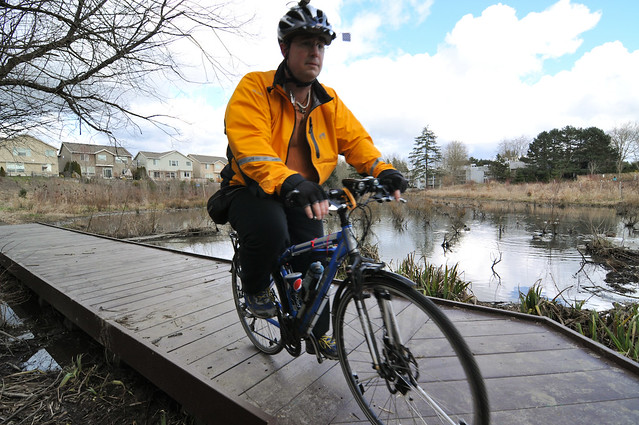

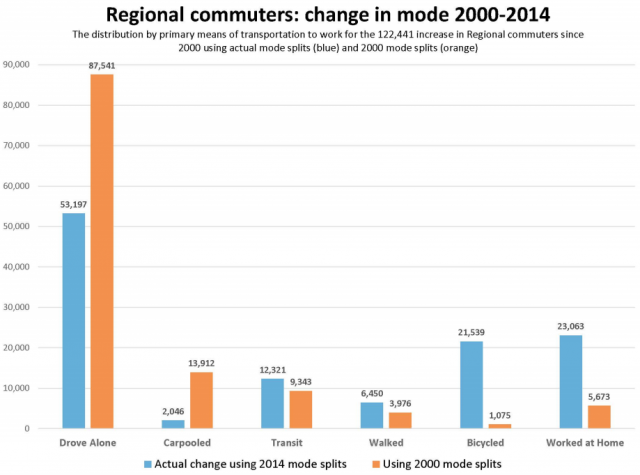
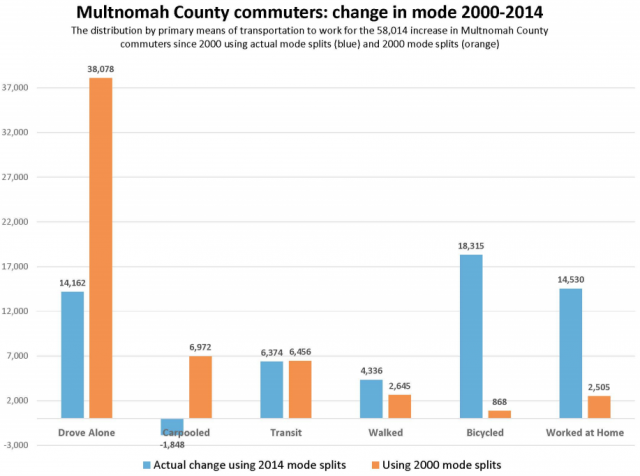
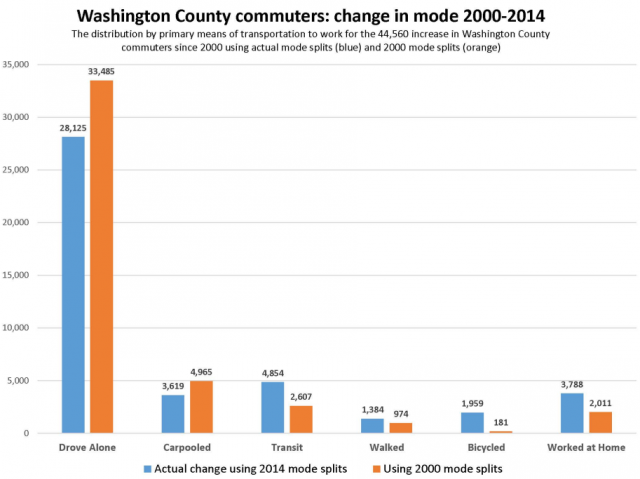
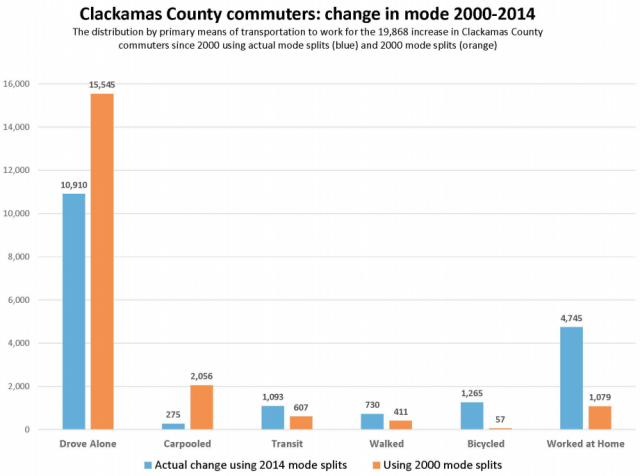
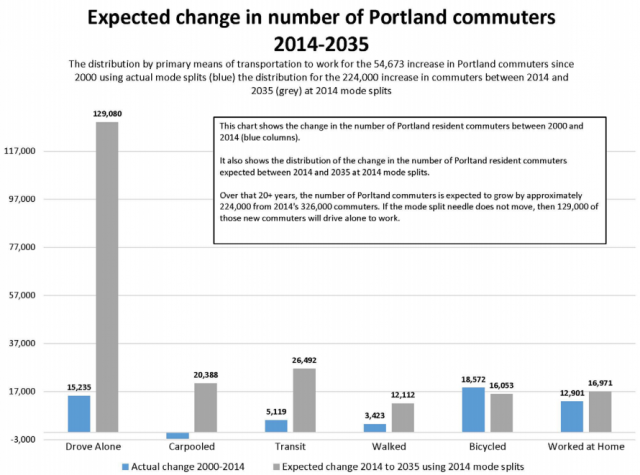
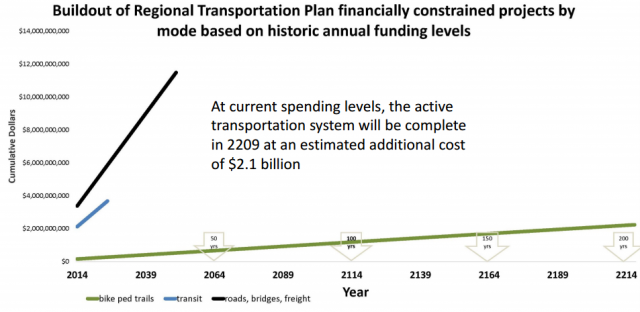
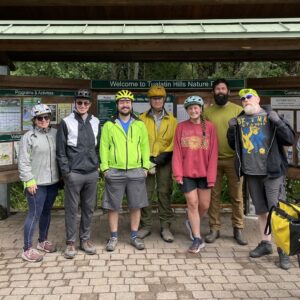


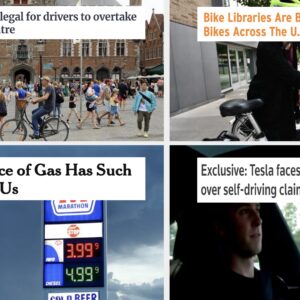
Thanks for reading.
BikePortland has served this community with independent community journalism since 2005. We rely on subscriptions from readers like you to survive. Your financial support is vital in keeping this valuable resource alive and well.
Please subscribe today to strengthen and expand our work.
And yet,Washington County is still adamant about wasting money on widening roads and not even adding bicycle facilities. We could easily fit a network of cycleways connecting the Tualatin Valley together, and in fact, the Tualatin Hills Park District already has some of the best cycle paths in the region.
When you give drivers handouts, of course people are going to abuse the system. We need to remove the car as the default mode that all other modes (including walking, cycling, bus, and train) must be shoehorned around. Every project in Portland and the Metro starts out with the assumption that we can’t make driving any worse, and that is absolutely the wrong approach. This is the exact reason the Powell-Division BRT project failed, and any project that starts with this assumption will also fail.
If Mr. Geller wants to avoid the nightmare scenario, then we need to start taking roads in Portland away from cars and dedicate space for cycling separated from motor traffic. This is something he himself could push for, instead of telling people that two miles of “greenway” without diversion will meet our goals.
The new Fanno Creek bridges on both SW Oleson Road and SW Scholls Ferry added wide sidewalks and average bike lanes. The project on Oleson removed auto parking on both sides of the road.
Yep, it’s frustrating. I live in Aloha and work in Hillsboro. If I want to bike, I can go down Rosedale, a sketchy back country road, to River road, a slightly less sketchy back country road with a bike lane where people speed, or, usually, I cut through back roads 2 miles to TV highway and catch the bus, then I go home a weird route that takes me 8 miles through side streets (where as a straight shot would be 6 if I wanted to risk my life on TV highway). It’s inconvenient, but thankfully there’s http://www.mapmyride.com. It’s ridiculous that there isn’t a safer bike route.
Living with quick access to the Westside and Fanno Creek trails is nice but lets not confuse any of the Tualatin Hills Trails networks as adequate paths for cycling outside of recreation. Most of the paths are meandering, inefficient routes built on land that had no other value (ie under powerlines or along a wetlands).
The Westside trail contains so much elevation gain and loss I rarely even see bikes on it and only made the mistake of riding on it once myself. They designed every road crossing so that you have to make a 90 degree turn down the sidewalk to the crossing, clearly signally that car traffic is the preferred right of way.
I commute daily almost the entire length of the Fanno Creek trail west of 217 and while it is a great scenic route being so close to the wetlands means critical portions of it are flooded late fall to spring. It is a winding path that can’t really be considered a dedicated efficient route for quick cycling transportation. The root bumps in some places are so rough I have to consciously slow down and navigate them when towing my 10 mo. old son in the trailer. (Also crossing 217 at Denny to continue NE on fanno creek is a shameful excuse for a portion of a trail system.)
Would love to see cycle paths built that show intent and purpose for cycling transportation, not just turning unused space into meandering recreation paths and calling it a bike infrastructure.
The lack of curb cuts on the Westside/Waterhouse Trails is frustrating, and makes those crossing much more dangerous for new riders than they should be. I’ve written THPRD and the county about it a few times, and they basically said that it’s the county’s responsibility, and that each crossing would require a big mid-block crossing treatment, costing lots & lots of money, of which there is none. They are waiting for money to fall out of the sky. They don’t want to just do the curb cuts because then people might just ride out into the road without looking, but the current format is ridiculous. You have to do a 90-degree turn on the sidewalk, ride down and find a driveway, and then make a u-turn in the middle of the road to get back on the sidewalk on the other side. My family & I did 10 miles of riding on the Waterhouse in April and I’m amazed we weren’t all yelling at each other by the end of it.
Maybe I’m interpreting something different from you, but I’m not seeing “even in suburban Oregon, drive-alone trips …[as] less than half of new commutes” per the headline or “And in all three counties, less than half of that net growth came from people driving alone in cars.” per the second paragraph.
Washington County: 28,125 new drive-alone out of 44,560 total = 63%.
Clackamas County: 10,910 new drive-alone out of 19,868 total=55%.
Am I looking at this wrong?
Nope, you were right and I was wrong. Fortunately I got the correction in just as you were typing this, or it would have been even more embarrassing.
Whoa, I thought you were crazy fast with the correction!
Epic fail of carpooling stands out here. Good to see more bikes on the road
Wow — the active transportation system will be completed by 2209! Now this I call a glacial path.
I think these graphs are great and useful for many, many conversations regarding why we want to invest in bicycle infrastructure: it is the cheapest way to prevent a traffic collapse. It is also good for neighborhoods, public health etc. but the fiscal argument here has perhaps the best chance to change people’s mind who are currently not in favor of spending more money for bicycling.
They can no more predict what will happen in 2209 than they can predict who the president will be at that time. To give any credence to such a graph is laughable; to pay pubic employees to waste time working on plans 200 years from now may be a crime.
I think the graph is an extrapolation based on the amount of money it would take to complete an “active transportation plan” and the historic rate of annual spending for “active transportation projects”.
Sad to see Washington County turn so many roads into freeways with many future plans. 8 lane intersection with SW Murray Blvd at SW Farmington Road being built by 2018.
Meanwhile Nike is adding twelve thousand new parking spaces to their campus, further cementing their employees reliance on driving alone.
Nike has never been a role-model for anything…
At least they’re paying for our bike share.
Nike is also adding over 1 million square feet of office space to it’s campus expansion. That means jobs! Which means more tax revenue, which means maybe WashCo and others can use that money for other transit investments.
Nike also just built a path though their own property from the Beaverton Creek MAX stop to the crossing to their campus on Jenkins. Nike also has shuttle services to several of the MAX stops to pick up/drop off their employees who choose not to drive. Is it ideal? No, but it is something. I bike or MAX by their HQ every single work day and I can tell you that yes, many employees there do commute via something other than a car. What % though, I have no idea, but I think your anti-Nike bias isn’t quite as informed as you wish it were.
I don’t have an anti-Nike bias; in fact I’ve worked there a few times. You’re right that they do more than most suburban companies do. The shuttles are nice, as is that new bike path. I just happen to think that 12,000 parking spaces is excessive. That, and their west campus is surrounded by parking lots and not terribly walkable. Yes, they did add sidewalks to improve the situation, but it’s nowhere as nice as the main campus, which is mostly car-free. And you have to assume that Nike has some influence over Washington County’s decision to widen all four roads that border their campus. Perhaps Nike could have used that influence to push for protected bike lanes.
AH,
Maybe Nike wants to reduce carbon emissions from cars idling on the narrow streets bordering their property, so they are being widened so the cars can move people more efficiently. Could be.
People will not ride bikes because you want them to – they will ride bikes when they decide they want to do so, OR when they are forced to by economic pressures – and those pressures will probably come unless some other affordable mode that is better than bikes comes along, and that could happen. We can’t predict the future.
And Kyles says:
“I don’t understand why more people don’t cycle since it is so much faster/easier than other options in most situations.”
Fact: driving a car is MUCH easier than riding a bike and it is much more comfortable during most of the year even in mild Oregon – imagine if you lived in flyover country where its COLD much of the winter. And if your commute takes you outside of downtown, then the car will be much faster. I’ve commuted 15 miles one way before by bike many times. Never did it daily though because it was too much of a hassle carrying your office attire in panniers, showering, taking your bike apart so all the accessories don’t get stolen during the work day, changing back to cycle gear (hopefully dry at the end of the day), putting bike back together, fighting traffic for 15 miles eating exhaust from hundreds of cars passing 3 feet from your nose, much of the year in the dark, rain, and uphill both ways, blah, blah, blah. Then if you want to go to the store on the way home and get something larger than a tic-tac you’re screwed. For those who want to do it great, and I enjoy doing it once in a while, but the comfy car, with heater on high for 15 miles, listening to good stuff on the radio, leaning back in that comfy foam rubber bucket seat, that’s niiiiiiiiiice – just stay off the freeways when they are stop and go – take the back streets instead. Economic changes will probably end car driving some day, but not yet. 🙂
You’re adding the the glut of cars on the road, polluting the environment and putting lives at risk every day. So you don’t have to put up with some minor challenges. Niiiiiiiiiiiiiiiiice.
I can appreciate it when people say that they don’t feel great about driving but just don’t have the time to cycle. That’s legit. But going on about the convenience of driving, while knowingly endangering the rest of us, is kinda weak.
I never endangered any cyclists. Being one myself, I pay attention when I drive a car.
Being a bike commuter without a car for 6 years in Portland, trained me. I’m hypersensitive to riders when I drive.
I’m a long time Washington County resident…in fact, I grew up less than a mile away from the Nike Headquarters. I’ve got a family member that’s worked there for years. Nike is unquestionably, an economic giant, globally as well as locally, and has been at the forefront of design leadership with its products.
It logically figures that if the company wanted to, really wanted to and recognized that it has an obligation to help confront and resolve some of the congestion issues its workforce commuting back and forth to work each day, contribute significantly to…Nike should be working actively and aggressively to encourage advances in design and development of transportation infrastructure emphasizing the use of walking, biking, and mass transit.
In this respect, Nike’s contribution to date, has been bits and pieces: the ‘ for on campus/between campuses only, bike share’, or the recently opened N-S MUP through Nike’s private tract of woodland immediately south of Jenkins Rd (according to a recent bikeportland story…only temporarily open to the public, closed on opening of the Westside Trail leg extending east of Merlo.).
Nike has the money and the influence to propose, design and help build a seriously functional basic cycle track system from its campus to surrounding neighborhoods ( …what I’d define as main lane separated/distanced bike lanes built for 10-20 mph travel by bike.). Yet, there seems to be no reports that the company is offering to do anything of this nature.
By the way….while THPRD is a great, forward thinking, and well managed park district, I think it’s great overstatement to assume it has built great cycle paths. It does have some very good off road asphalt paved paths, but these are MUP’s….in other words, ‘recreational paths’, rather narrow, with plenty of people walking on them. They’re not suited well at all for commuting by bike at much over 5 mph.
The vortex of road infrastructure development out here in Washington County, still does seem to be powered towards widening of country roads, primarily for the movement of greater numbers of motor vehicles; walking and biking enhancements to this widening, seems ever to be a secondary, relatively minor addition. Unfortunately.
I don’t understand why more people don’t cycle since it is so much faster/easier than other options in most situations.
I suspect the reason more people don’t use transit is that it runs too infrequently, is often very crowded, and is way too slow. I pass MAX trains all the time even where the stops are spaced out and the buses are even worse. The situation downtown is hopeless.
The only method of transportation that’s worse is by car. For some reason, sitting still going nowhere and then having trouble finding parking is considered “freedom.” Reminds me of a quote from a Speed Racer cartoon I saw more than 40 years ago:
Q: “Can’t we go any faster?”
A: “Yeah, but then we’d have to walk….”
Concerns about safety, for one. There’s too much motor traffic in this city and we have very little separated facilities. Building out protected cycleways is key to improving the perception that cycling can be safe and easy. Bike shops that sell upright city bikes instead of uncomfortable racing bikes is another, but Portland already does a good job of that.
Racing bikes are more comfortable on a long ride. I’d hate to use a city bike on my commute.
That said, I agree with your first point. If not for the path that runs along Hwy 26, I never would have become a bike commuter.
While I do agree with you, I’m looking at this from the viewpoint of someone who wants to start riding that currently doesn’t. Which seems less daunting to that person: a bike that requires you to wear special clothing, can’t carry any luggage, forces an uncomfortable hunched-over position that makes it hard to see the road, and requires the rider to know what accessories they need to add it it; or a bike that comes ready to ride out of the box with fenders, racks, chain-guards, and a comfortable upright riding position that one can just hop on and ride, no matter what they happen to be wearing that day, and have somewhere to stash their laptop bag?
Not knocking road bikes if that’s what you prefer. But selling someone a racing bike for commuting does more to scare them off, rather than make cycling look easy and fun. There’s a reason that bike share systems all use upright utility-style bikes.
and so far, they have been so successful…..
Clearly it’s not just about the style of bike. We need safe places to ride as well.
I know what you are saying Adam, but as someone who has lived and biked in Portland for a long time, I can tell you that cycling and commuting began to take off here after the hipsters discovered that those old “10 speeds” went a lot faster and were a lot more fun to ride than the upright bikes their parents bought them as kids.
Go stand on Williams some day and tell me how many upright cruiser bikes you see being ridden in the real world….
Not sure why everyone here is thinking a proper city bike is the same thing that the parents of kids in the 70s had? Like city bikes haven’t changed since the 50s or something.
The fact is that most people starting out with riding are going to be a lot happier on something like a linus or a public than anything with skinny tires and drops.
Or perhaps so many people ride racing bikes because that’s what our city designed it’s infra for?
And then there is the rain…
No bike is better than another bike for commuting. Everyone has different needs. One of my coworkers rides in on a downhill mountain bike with massive travel — he likes to jump things on his way in.
Best to stop trying to apply your> solution to everybody else.
We should be encouraging what works…
I commute every day and have for a long time. I see all the other bikes on the road, there are very few “city” bikes among cycling commuters.
Why do you want people to buy bikes that they will not use….
Ignoring for a moment the idea that what you see on your morning ride constitutes a valid argument, the likely reason you see very few city bikes is because the majority of our bike infrastructure has been designed without any separation or diversion, forcing people to ride fast to keep up with motor traffic. Plus, just because the 7% of people who ride today ride road bikes, doesn’t mean the other 50% or so interested in riding want to. Perhaps the thought that they need to ride fast is a deterrent for them starting to ride! Who wants to show up to work all sweaty and have to change clothes?
And as long as we’re playing the personal anecdote game, I saw plenty of upright riders on my ride in this morning from SE Clinton to downtown, including the owner of this website. 🙂
Adam, as someone who currently relies on Transit/car and would like to start commuting by bike, I think you’ve hit the nail on the head. Personally, I’m looking at getting an upright electric assist bike with fenders and a rack. Upright, because I find it more comfortable, and I feel I can look around more easily. Electric assist, because I would be riding 10 miles in an area with quite a few hills, and there’s no shower at work. Fenders and rack (preferably pre-installed), so that I stay dry(er) and I won’t have to schlep everything in a backpack.
I also agree with your earlier comment about protected cycleways. As a newer rider, one of the hesitations I had was the poor quality of bike infrastructure in Washington County (where I live/work). My commute options are bike lanes along wide, fast moving roads, or the Waterhouse/Westside trail with several gaps that make it somewhat circuitous. If Washington County had better bike infrastructure, I have little doubt that more people would ride.
“…Personally, I’m looking at getting an upright electric assist bike with fenders and a rack. Upright, because I find it more comfortable, …” jack
Yes…I think many of the future, yet to start riding commuter, and short trip riders, may take to e-bikes like crazy, especially if there were at least a decent off-main lane cycle track/bike path system.
I love riding road bike, but I believe also, there are many people to whom that type bike continues to be firmly and irrevocably lodged in their psyche, as one they’ll never seriously consider riding, because its ‘too risky…oh, my aching back!, etc, etc.)’. If the bike they think about riding doesn’t seem and feel to them, about as safe and comfortable as their exercise bike set up in their tv room…they’re not going to try it.
“I love riding road bike, but I believe also, there are many people to whom that type bike continues to be firmly and irrevocably lodged in their psyche, as one they’ll never seriously consider riding”
Yes, because we have had so much success getting people to use their city bikes for transportation…..
TV highway has a shoulder that is very wide in most places – probably 6 feet, maybe more. Much of Hall has a good shoulder/bike lane. It’s not separated so you are taking your chances, but it’s not bad. Help the cars to see you – wear fluorescent yellow or orange in the day and reflective materials at night in addition to your flashing lights – plural at least 2 on the rear. Washington county isn’t bad at all – much preferable to just about any place downtown.
Ebikes are the future for long commutes. Someday I’ll be the geek on an e assist recumbent with a wind faring.
You mean heavy bikes that discourage people from cycling? Those kind?
Almost every person I know who buys a decent road bike for travel rides a lot and is happy doing it.
The people I know who buy heavy upright old school bikes store them in the back of the garage.
I don’t know anyone that stores them in the back of the garage. In fact, in my experience with friends & family, this kind of bike encourages a lot of people to ride that would not feel comfortable otherwise. I own four different kind of bikes myself (all stored in my apartment, btw) & find I tend to enjoy riding my heavier cruiser-type bike for my (year-round) commute from Milwaukie to Portland. It’s nice to take it a little slower & actually enjoy the scenery along the river.
And by going a little slower, you are probably safer in many circumstances.
And less safe in others.
I rode over Hawthorne this morning as usual. 9 bikes on the bridge.
Not ONE upright city bike. 7 drop bar bike and 2 flat bar road bikes.
Those heavy bikes are getting a lot of use…….
You missed me then, since I rode over the Hawthorne this morning. 🙂
My favorite commuter bike is the 5000 dollar Cervelo, maybe they have a long commute or ride after work…
I don’t see any upright bikes going up through Washington Park.
If they are there, I’m passing them so quickly that I don’t notice them.
Clever Cycles seems to be doing very well, so clearly someone is buying and using those upright city bikes. 🙂
Again, not to people who ride where I ride.
Sure, and I would likely not be happy riding my city bike over the hills either! I understand that city bikes are not suited to every situation, however they do work for most people that just want a way to get to work, carry groceries, etc, and I’m willing to bet most of those people don’t want to ride over the hills every day. With bike share coming this summer, it will become very practical for Washington County commuters to ride to Beaverton TC or Sunset, take MAX through the tunnel, and bike share the rest of the way. We just need better facilities west of the hills. And hey, if you enjoy riding over the hills, then by all means, buy the bike that works for you!
You clearly don’t know me then. 😉
I ride a chrome moly framed 1991 Bridgestone CB1 with full fenders, racks, panniers and a longer front quill so I can ride upright. It’s got a 7 cog cassette, 3 front rings and weighs 32 pounds empty panniers. Unladen roadies pass me, no one else does. I live on Marrowstone Island, near Port Townsend, and I’m turning 59 in a month.
I ride for transportation and pleasure. It doesn’t seem to slow me down any.
@Kyle Banerjee: Actually, suburban MAX trains average about 30mph over their route, which is quite competitive with driving. Speed really isn’t a problem for MAX, except downtown (where it is admittedly very slow). It’s buses that are slow … urban buses are mostly in the 10-15mph range, and suburban buses rarely average more than 15-20mph.
But I don’t think it is vehicle speed that is the biggest negative for most people riding transit; it’s frequency. If you have to wait 20 or 30 minutes for a single transit vehicle it’s maybe a bit of a hassle to time your departure to coincide with the run, but easily manageable with all the good transit apps out there.
But add a transfer – and most people do need to transfer to get from A to B – and infrequent service really starts to hurt. Because then a 30 minute interval between buses is no longer a timing issue, it’s time added to your trip. I think TriMet needs to consider increasing frequencies on MAX, which still often goes 20 or minutes between runs.
Here in Minneapolis, the light rail lines run every 10 minutes, all day, no matter what. Which is great not only in terms of frequency and reducing transfer waits, but also just makes things simpler. If the train comes by at :06, you know they also come by at :16, :26, :36, :46 and :56. TriMet would first need to improve reliability to pull this off, however. I’m hoping the current downtown track/switch project will help with that.
Yep! Short headways are key. When I was in Paris, I took the Métro everywhere, and they have headways we can only dream of, typically in the 2-5 minute range at almost all times (they shut down for a few hours at night). There were lots of times I had to transfer, but rarely hat to wait more than a few minutes.
Meanwhile, our “frequent service” bus routes arrive every 15 minutes. Shorten that to 5 minutes and you have a decent system for transferring.
Yep, true high-frequency service is out of reach in most of America. Same deal here in Minneapolis – although we have a pretty good network of “hi-frequency” routes, that means 15 minute headways, not 5.
I’ve always been envious when I’ve visited cities (including Paris last summer) that had subways with really frequent timing, where having to transfer didn’t triple or quadruple the travel time. FWIW I was also in London last summer, and although in some ways the Underground is far more pleasant (especially for families) than the Paris Metro, I was much less impressed with the Tube’s reliability and frequency of service.
People are brought up from infancy in cars in this country. It’s completely normative. They think bikes are toys and it’s very very hard for people to think outside of that box. Sadly I think for most Americans cars symbolize adulthood and for them there really is no viable alternative.
I heard some yuppie complaining about being forced to take Tri Met once when her car broke down, she was honestly afraid she’d contracted diseases from the bus seats… her friend was sympathetic and told her she should see a Dr. immediately just to be sure.
That’s where we’re at… you can tell from the pro car people’s comments on this website, they just see the cars as the default way to get around.
I’m glad to see working at home mentioned. Getting people out of cars and onto bikes or public transportation is good, but eliminating the need for the commute is even better.
Especially in the case of streetcars and light rail, proponents often seem to think getting those built and used is an end goal, rather than thinking of them as just two of many tools that can be used to reduce negative impacts of commuting. But they have huge costs and expenses compared to simply eliminating the commute.
The BTA doesn’t think about working from home either. If I go into work 3 days a week and bike every day, I’m a 60% bike commuter.
The downside of working from home – which I do most of the time now myself, FWIW – is that if your job can truly be done 100% from your house, it can also be done from Bangalore.
I have a coworker who moved to Spain a few years ago and managed to keep his job. We were trying it out on a trial basis, but it’s worked out very well for us, as it gives us more round-the-clock coverage.
I guess on the positive side the guy in Bangalore wouldn’t be adding to traffic here.
Seriously though, most jobs can’t be done 100% from home, but many can be done partly at home, and that’s where the real growth could come. If someone can do enough at home that they can stay home 1 day per workweek, that’s a 20% drop in commuting–the same impact as if the region somehow convinced 20% of car commuters to switch to transit. Actually better, since it takes the bus off the road, too, and costs nothing.
Or, even if all that can happen is that someone can do an hour or two at home now and then, that can mean a few trips per week in off-hours instead of rush hour–still a huge positive improvement if enough people can do it.
Also true. If I get stuck at home in the morning for some reason, I’ll wait until traffic lightens up before heading in.
I know several people in Milwaukie & to the south that have started driving downtown again since the Orange Line started. A commute that used to take 15-25 minutes on the bus now takes three times that long.
I like and use public transit for my commute when I’m not biking, but the Orange Line (as currently configured) added time to my transit commute rather than reducing it. There are a few days a year when McLoughlin is so backed up that the train will provide an obvious benefit, but otherwise the old 32, 33, and 99 routes served me better.
The Orange Line really needs to be extended to Oregon City.
The Orange Line really needs to be extended to Oregon City. Recommended 4
The old trolly line bridge over the Clackamas was destroyed just before the orange line was started. It is now ready for the line to be extended and a new bridge built.
It would be nice to run it to Oregon City, cross the Willamette to West Lynn and run back north on the old trolly line to L.O. with new rails of course.
And extended on the North side to St Johns.
The 2000-2014 Portland “actual change” in commute numbers argue that much of our cycling mode share increase is due to newcomers.
That would be us. Portlanders since 2006. Sold the car two years after moving here because we rarely used it.
The data is shows NET changes in commutes by mode. It doesn’t show if the new bike commuters are young locals who got a first job, old-timers who changed to biking, or new arrivals from out of town.
On a mode share basis the net change in commutes for people biking (~18%) looks very different from our current cycling mode share split (~7%). I think it’s very unlikely that those ~22,000 new commutes all represent pre-existing residents.
The return on investment for all that work-from-home infrastructure we’ve installed has been outstanding!
That’s why it was so great to see it mentioned finally in an article about commuting. Zero cost to the public, yet almost ignored, while streetcars and light rail cost billions.
It’s not possible for most people, but can still make a huge dent, as the statistics show is already happening.
It doesn’t need to be 100% either. If someone can work at home 1 out of 5 workdays per week, they’ve just reduced commuter trips by 20%. For that matter, working outside the home 4 long days/week instead of 5 shorter ones does the same thing. But these are almost never mentioned as traffic solutions.
Also, reducing the number of trips you take or picking better times to be on the road has an impact. It’s interesting to see how many people are out shopping on Friday at 4pm, and likely complaining about how bad the traffic is. Take some personal responsibility for traffic.
Yep, non-commute trips count too! Having neighborhood grocery stores that can be walked to make a huge impact on reducing car reliance.
Yes, good point about timing trips. People complain about roads being at or over capacity, but most of the time, they’re way under it, even on the most “crowded” routes. A driving trip in rush hour isn’t at all equal to the same trip at off-peak times.
Now that’s funny… Me seeing my old pic on my birthday, while I live nowhere near Washington county (currently)
The lag time is huge. In the bad ‘ol days when I was in the Soviet Union, the metro ran every 2 minutes, every 1 minute at rush hour (you couldn’t even walk the length of a train before the next one arrived). When wait times are short, it becomes much more practical.
For commuting, MAX works reasonably well. The Sunset and the Banfield are consistently total disasters and I-5 as well as parallel lines like Interstate are slow as goo for drivers. But getting to MAX from the start and destination points is an issue.
I love the idea of public transit and own a subsidized pass. But I find it a slow and frustrating experience and regret not just cycling the few times a year I use it.
The Soviets did that stuff right. I was in Prague this last summer and I have never seen such an efficient light rail / subway system. Incredible. i didn’t even know it was possible.
That stood out to me, too. I’m digging the mode share increases in biking, transit, etc. but I’d also like to see efforts to shift at least some of those Drove Alone trips to the Carpool column.
I agree. I also wonder how much info there is about carpoolers. Is the dropoff due to carpoolers becoming single drivers (my guess, and bad) or bikers or transit users (good)?
A lot of resources have gone into carpooling, such as the dedicated lanes on freeways. Are these effective enough to justify? How many of those people are actual carpoolers, vs. say people driving their kids to school?
What dedicated lanes on freeways? Maybe i don’t drive around Portland enough, but I don’t know where these are
I-5 northbound from just north of downtown to the Interstate Bridge in Portland, during rush hour. Many other cities have them also.
There will always be a few carpoolers, but as a widespread solution carpooling is basically Over. I think the main reasons are flexible work hours, and no-longer-free-ranging kids increasingly being driven to school and afterschool activities.
Back when everyone in a given office worked the same hours, and drove straight between home and work without dropping off/picking up/schlepping the kids along the way, it was easy for coworkers who lived in the same neighborhood to easily carpool.
I think the dedicated lanes *are* worth it, if for no other reason than they allow mass transit to bypass the backups. Admittedly Portland has a pathetic number of these lanes (one!) given its population of 2.5 million, but places like Seattle have them on most freeways. In fact, I believe some of Seattle’s freeways (SR520 maybe?) have a minimum of three occupants to qualify for use of the carpool lane.
An alternate solution to the mass transit problem, which we’ve adopted in the Twin Cities, is allowing buses to drive on the shoulders. This system actually works great, and it cuts my 6 mile trip downtown on the express bus to 12 minutes, as opposed to 35 minutes for the milk-run bus. All in all we probably only have carpool lanes on half a dozen freeways, but MnDOT is a lot more aggressive in using ramp meters to keep excess numbers of cars off the freeways to maximize throughput, and we do have a lot of carpool lanes on the metered ramps. Our carpool lanes are also so-called “Lexus lanes” (which I have mixed feelings about), where solo drivers are allowed to buy their way in, with the current fee (varies hour-to-hour depending on congestion) displayed on message boards above the lanes.
Not sure how you would define “effective” when referring to carpool lanes. In Seattle, a relatively small number of cars use them because most cars have only one occupant. The other lanes are stop/go – so the carpool lane does nothing to reduce congestion, except for the few who can use it. Everyone else is stopping/starting and belching CO2 at the maximum rate possible.
Everyone can use them.
Exactly. This is the fallacy that so many people fall into: carpool lanes are for other people, so why should I pay for them? Go to a little effort to find a passenger, and you, too can use the carpool lane. Bike lanes are for “those bikers” so why should I pay for them? Again, go to a little bit of effort to leave your car at home just once, and you, too can become one of “those bikers” and use the bike lane. Same goes for trains and other transit. The only reason most people claim they get no benefit from a particular thing is because they choose not to use it. If only people viewed driving a car as a transportation choice rather than taking the view that transportation=cars.
Actually, you don’t even have to use carpool lanes, transit or bike lanes to benefit from them. All three encourage people to travel without cars. Every biker, or carpool or transit passenger, is someone who likely would be in a car adding to congestion if they hadn’t been offered those other options.
Not everyone’s situation is conducive to biking, carpooling or using transit, but that doesn’t mean they’re not benefiting from them.
This, too. Reminds me of the old Onion article: “Report: 98 Percent Of U.S. Commuters Favor Public Transportation For Others”
That’s how I feel about religion too, ha ha.
The idea that people working at home holds potential for reducing ‘drive alone’ trips by motor vehicle, is an interesting one. I personally know two people from different households, that work at home. Big advantage of that working arrangement in terms of road congestion contribution, is that they’re examples of people that don’t have to drive in the am/pm commute…but they still drive, and by themselves, a lot, outside of commute hours when bumper to bumper congestion isn’t occurring.
In terms of general motor vehicle traffic congestion today in Washington County…it seems to be steadily worsening, despite the various ‘road improvement projects’ the county takes on, and whatever numbers of people are electing to work at home.
I’m very much a realist, I think, or at least I try to be, in terms of the limitations of bikes for travel compared to personal car motor vehicles for travel. However, I think county transportation planners may be making a big mistake in continuing to prioritize road widening within small communities and cities the size of Beaverton, for motor vehicle use, over prioritization of road infrastructure for walking and biking.
Maybe it’s somehow possible to do without replicating an L.A. road infrastructure nightmare here in Oregon, but it seems not likely that road infrastructure widening for motor vehicle use, can keep pace with the growing population, and its corresponding motor vehicle use, if road infrastructure for motor vehicle use continues to be the major road use priority it is today.
As I heard it (directly from one of the county commissioners) the Bethany widening project was done to appease the developers doing all of the new construction north of the Bethany neighborhood.
Large developer contributes lots of money to commissioners’ campaigns –> developer requests certain road sizes and speeds to get to their developments –> commissioners make sure it happens –> repeat cycle.
The token sub-standard bike lanes and sidewalks seem to be added to these roads to help gain public support for the projects (bike lanes and sidewalks look appealing in the drawings).
I don’t know how they measure success for projects like this. You might think it would be useful to look at bike/ped numbers on a road to see if the bike/ped facilities are attractive enough to be used, but I suspect they only care about car throughput.
The Oregon bike bill requires bicycle facilities to be built on any new or reconstructed road. Unfortunately, facility is not defined to include full separation, so we typically end up with sub-standard painted bike lanes.
In this context, it’s below even their own low standards. The plans called for 5-foot-wide sidewalks and 5-foot-wide bike lanes, and they are clearly skinnier than that.
This:
http://projects.whpacific.com/_Source/BethanyBlvd/Design%20Drawings/Selected%20Design/Bethany%20Bronson%20to%20West%20Union%20cross-sections.pdf
is more appealing than this:
https://goo.gl/maps/U82crkeDZgy
Painted bike lane is better than nothing. Given the weak economy and the fact that most of the tax money is spoken for by other demands, I’ll take bike lanes if I can get them.
What weak economy?
How strong do you think our economy would be without that extra $534 billion dollars the feds are spending that they don’t have this year? And how about the several years with deficits as high as $1.3 trillion? Get a clue.
Since you were talking about Washington County, well, they have plenty of money for development. They just choose to spend very little of it on development for walking & biking.
This one:
http://www.oregonlive.com/education/index.ssf/2015/03/portland_has_no_2_highest_food.html
Do a lot of riding next to cars doing 45 to 60mph while in a bike lane? I’d rather have no bike lane in that situation, where at least cars are legally obligated to pass at a safe distance (not that they always do). On roads like Murray, drivers can pass you just inches away while doing 55mph. On Bethany, cars frequently drive in the 4-foot bike lanes because they can’t manage to stay in their own lanes when the road curves, and the right third of the lane is useless, so that doesn’t leave much space at all.
Yes, I do. I ride West Union. White line is on the dirt. I’d prefer a bike lane thank you very much.
I’m not sure you understood my question. If a white line is on dirt, it’s not a bike lane, and it has nothing to do with cycling.
He said “white line”, not “bike lane line”, aka “West Union does not have a bike lane”. I’d have to agree that I prefer my own lane opposed to sharing a lane with cars on roads with >30mph traffic. I ride Murray often and find that cars pass uncomfortably close much less often than compared to roads with no bike lane. (I know you said legally obligated, but reality is what I tend to go by).
I may be a minority around here in that I would rather see car speed / right of way reduced and bike and cars intermix more smoothly. As a cyclist who prefers to get places efficiently I’d rather ride at 20 mph around cars going 30 than deal with being put onto a sidewalk with pedestrians and further contribute to the stigma that cycling is dangerous and we should keep cyclists out of the way of cars. Once cars are going less than 30mph I prefer to completely share the lane. I know sharrows are hated around here but again, would rather the mindset regarding car vs bike traffic be changed. (Although if someone is going to be cycling slower than 10mph then they should probably be grouped with pedestrian traffic.)
I suppose it’s personal preference. I’d rather ride a two lane road like Skyline or West Union than a 4-5 lane stroad like Evergreen, Murray, 185th, etc. You may like the changes coming to Washington County, where they hope to ‘improve’ parts of West Union and Walker by turning them into 5-lane roads and adding bike lanes. IMO, these widening projects have little to do with bike lanes and are more about car throughput and speed; the bike lanes will likely be the bare minimum again, and will be the first thing they shrink if space gets tight.
I like sharing the lane too. I’ve always got lots of room on either side of me when I’m in the middle of the road.
Not sure what you mean about sidewalks. I avoid those too when possible, though I tend to ride on the sidewalk with my family when we ride on Bethany. They’d be terrified in that bike lane.